Heinz-Steyer-Stadion
| Capacity | 10 343 |
|---|---|
| 5400 (Covered seats) | |
| Country | Germany |
| City | Dresden |
| Clubs | Dresdner SC, Dresden Monarchs |
| Inauguration | 30/08/2024 |
| Construction | 2021–2024 |
| Cost | €54 M ($60 M) |
| Design | O+M Architekten |
| Contractor | ZECH Group |
| Address | Pieschener Allee 1, 01067 Dresden-Friedrichstadt |
Advertisement
Heinz-Steyer-Stadion – stadium description
What is the Heinz-Steyer-Stadion like in brief?
The stadium, originally built by Dresdner SC, was completed shortly after World War I. Over the years, it hosted national team matches (both for Germany and East Germany), championship deciders, and East German Cup finals.
The stadium witnessed multiple world records being set. It also hosted national athletics championships and Peace Race stage finishes. Near the end of World War II, it was hit by a bomb, and in the early 21st century, it faced major floods.
Between 2021 and 2024, the venue underwent a thorough reconstruction – the only remaining element of the old stadium was the relatively new northern stand. The “new” Heinz-Steyer-Stadion was inaugurated on the weekend between August and September 2024.
The stadium features a nine-lane athletics track and a natural grass pitch. It can accommodate over 10,000 spectators, with around half of the seating (along the sidelines) sheltered under a roof. A large video screen is mounted above the northern stand.
The main (southern) stand houses extensive facilities, including additional sports areas such as a fencing hall and squash courts.
A distinctive architectural element is the steel ring structure, supported by tall reinforced concrete columns, which encircles the venue. It serves both as a mounting frame for the floodlights and a striking visual feature that ties the whole building together.
A permanent landmark in the stadium’s backdrop is the Yenidze building – a former tobacco factory built in an Oriental style, easily recognizable by its dome visible behind the main stand.
The stadium is located not far from Dresden’s historic city center and forms the core of the “Sportpark Ostra” complex. It is the second-largest and most important stadium in the city, after the football-specific Rudolf-Harbig-Stadion.
What was the history of Heinz-Steyer-Stadion before the 2021–2024 reconstruction?
Construction of the stadium began in December 1918, and it was officially inaugurated on October 12, 1919. It was built by Dresdner SC, a club that enjoyed its greatest success during World War II, winning the German championship twice (in 1943 and 1944).
After the war, Dresdner SC was dissolved and its assets were seized by the communist authorities. In its place, SG Friedrichstadt was established. This successor team contended for the East German championship in the inaugural 1949/50 season, but the decisive match on the final matchday turned into a major scandal, and the club was disbanded shortly after.
Subsequent users of the stadium included clubs such as Dynamo (which won the East German title in 1953 while playing there), Einheit, and Lokomotive. After the fall of the Berlin Wall, a “new” Dresdner SC was formed, seeking to restore the traditions of the original club.
On June 21, 1949, the stadium was named after Heinz Steyer – a communist activist, footballer, and victim of the Nazi regime.
The stadium became known for its world records. In total, 13 official athletics world records were broken here, and one more was equaled. Records were also set in more unusual disciplines, such as backwards 10 km running and angling. The venue also hosted national athletics championships of both Germany and East Germany, as well as numerous other athletics meetings.
It was the site of national football team matches (both for Germany and East Germany), East German Cup finals, the 1949 Ostzone championship decider, performance by the Alexandrov Choir, Peace Race stage finishes, and many other events. In 1945, the stadium was hit by an Allied bomb, and in the early 21st century, it endured severe flooding.
Between 2021 and 2024, the stadium underwent a complete redevelopment. The only major structure retained was the relatively new north stand, built between 2015 and 2017.
More details on the stadium’s history prior to the 2021–2024 reconstruction can be found on a separate subpage
When was the “new” Heinz-Steyer-Stadion built?
Between 2015 and 2017, a new, fully covered reinforced concrete north stand was built at Heinz-Steyer-Stadion at a cost of around €4 million. It was officially opened on August 4, 2017.
Following the completion of the north stand, the city decided to proceed with a full-scale redevelopment of the stadium. On June 28, 2018, the municipal authorities announced plans for a comprehensive reconstruction. A preliminary development study was prepared by the city-owned company STESAD GmbH.
When was the general contractor for the reconstruction selected?
On July 1, 2019, a competitive dialogue procedure was launched to select a general contractor. Three candidates entered the process: the BAM consortium (based in Düsseldorf), Ed. Züblin AG (Stuttgart), and the Austrian company HABAU.
On November 17, 2020, the BAM consortium’s bid was selected as the winning offer. The design for the reconstruction was prepared by O+M Architekten, in collaboration with the planning office phase10.
On January 28, 2021, the Dresden City Council unanimously approved the project, and on February 15, 2021, a contract was signed with BAM Sports GmbH (which became ZECH Group in October 2021).
When was the Heinz-Steyer-Stadion renovation carried out?
On October 26, 2021, Mayor Dirk Hilbert inaugurated the stadium’s renovation, which began with the demolition of the old main stand. The building located in its central part, constructed in 1929, was demolished in November 2021.
The foundations for the new main stand were laid between February and March 2022. The cornerstone laying ceremony and the time capsule burial took place on June 2, 2022.
On April 4, 2023, the topping-out ceremony was held, symbolically marking the completion of the new southern stand’s shell construction. The event was attended by Mayor Dirk Hilbert, representatives from the sports and political communities, and individuals involved in the project.
In April 2024, a new running track was installed, and in May, photovoltaic panels were mounted on the roof of the main stand. The stadium was ready by the end of June and was officially handed over to the city on July 1, 2024.
The renovation cost approximately €54 million (initial estimates were €37.3 million) and lasted nearly a year longer than originally planned.
What did the 2021–2024 renovation include?
During the works carried out between 2021 and 2024, the stadium was thoroughly rebuilt. The relatively new northern stand, built between 2015 and 2017, was retained. The main stand was constructed entirely from scratch, and the stands on the curves were also rebuilt.
A steel structure with installed floodlights was erected around the venue. The entire facility was comprehensively refurbished, including the installation of a new running track and natural turf, as well as improvements to the surrounding area.
The scoreboard, which had been out of use since 2007, was removed from the stadium. It was replaced by a new video screen mounted above the northern stand, installed after the renovation was completed, in July 2025.
When was the renovated Heinz-Steyer-Stadion inaugurated?
The official reopening of the renovated stadium took place on August 30, 2024. The event featured the 7th edition of the revived Goldenes Oval athletics meeting in front of a full crowd.
The day before the official inauguration, on August 29, a mass street run called Stadium Run was organized – a 5 km race connecting Dresden’s two main stadiums: the start was at Rudolf-Harbig-Stadion, and the finish at Heinz-Steyer-Stadion.
An open day was held at the stadium on August 31, 2024, and the Dresden Monarchs and Dresdner SC teams played their first matches after the inauguration on September 1 and 4, respectively.
What is Heinz-Steyer-Stadion like?
The stadium features a tartan nine-lane athletics track and a natural grass pitch. The track is surrounded by stands forming four main sections: two stands along the pitch and two stands on the curves.
The stadium’s capacity is 10,343 spectators, of which 5,400 seats are covered (the stands along the pitch). Temporary stands can be installed on the curved sections, allowing the capacity to be increased to over 15,000 if needed.
The seats are arranged in a mosaic pattern with white, light beige, and shades of green. The north stand, built earlier, has blue seats with some gray ones mixed in.
One seat in the main stand is designated as the honorary seat of Helmut Schön (Helmut-Schön-Ehrensitz), commemorating the former Dresdner SC player – who won two German championships with the club – and later was the West Germany national team coach, who led the team to the 1974 World Cup title.
The main stand, located on the south side, is a four-story building containing extensive facilities, including a fencing hall, five squash courts, a gym, rooms for gymnastics, ballet, and other courses, as well as a cycling training area.
The facade of the main stand is made of trapezoidal metal sheets, and a narrow, long LED display is installed above the main entrance. The main stand’s roof is equipped with 750 photovoltaic panels.
The western curved stand is higher than the eastern one, which features the stadium’s entrance known as the “marathon gate”.
On the outside, the eastern curve is surrounded by sturdy flood protection walls. These walls extend along the northern stand, gradually decreasing in height and eventually replaced by a flood embankment.
On the outer wall there is a sign with the stadium’s name and a commemorative plaque listing the world records set at the venue. The plaque was unveiled on March 27, 2025, after the previous one (from 2011) was stolen and destroyed during the stadium’s renovation.
Around the venue runs a steel ring supported by tall reinforced concrete columns. This structure serves as a frame for the floodlights and also acts as an impressive architectural element, visually tying the entire building together.
Part of this structure is an approximately 115-meter-long truss stretching over the roof of the north stand, with a large LED screen mounted on it. The top external part of the entire ring is covered with metal panels, extending the facade of the main stand.
What is Heinz-Steyer-Stadion used for?
Heinz-Steyer-Stadion is the second largest stadium in Dresden, after Rudolf-Harbig-Stadion. Unlike Rudolf-Harbig, Heinz-Steyer has a more multifunctional character thanks to its athletics track and additional sports facilities in the main stand.
The stadium is regularly used by the Dresdner SC football and athletics teams, as well as by the American football team Dresden Monarchs and the women’s football club 1. FFC Fortuna Dresden.
It can host a variety of cultural and sporting events. After the 2021–2024 renovation, the tradition of hosting the Goldenes Oval athletics meetings was resumed.
The German Athletics Championships were held at the stadium from 31 July to 3 August 2025 (as part of the multi-sport event Die Finals – Dresden 2025). The national championships thus returned to the stadium for the first time since 1920 (although in the meantime it had also hosted the East German Athletics Championships on six occasions).
From 17 to 24 August 2025, the stadium served as the main venue for the 24th edition of the Summer World Transplant Games.
Where is Heinz-Steyer-Stadion located?
The stadium is situated relatively close to the city center – just over a kilometer to the northwest – near two adjacent bridges over the Elbe River: a road bridge and a railway bridge (Marienbrücke).
The distinctive railway bridge, dating from the turn of the 20th century and featuring arched stone spans, is clearly visible from many areas of the stands. Trains frequently pass over it, creating a characteristic backdrop during events at the stadium.
The most recognisable building in the stadium’s surroundings is the so-called Yenidze – a former tobacco factory built in an Oriental style between 1907 and 1909. Topped with a striking dome, it is visible behind the main stand.
What is Sportpark Ostra?
Heinz-Steyer-Stadion is the central feature of a larger sports complex known as Sportpark Ostra, named after the surrounding district of Ostragehege. The complex spans a considerable area to the northwest of the stadium.
It includes a sports hall (BallsportARENA Dresden) and a smaller fencing hall, both located directly behind the main stand, as well as an indoor ice rink (which has operated under various commercial names, including Freiberger Arena, EnergieVerbund Arena, and Joynext Arena) and a training hall used by Dresdner SC.
Other facilities within the complex include oval tracks for ice and roller skating, tennis courts, beach volleyball courts, and a figure roller skating venue. The northern part of Sportpark Ostra consists mainly of football training pitches, including one surrounded by an athletics track.
There are also car parks and bicycle stands around the stadium. In the vicinity of the south-eastern corner stands an obelisk commemorating the stadium’s namesake, Heinz Steyer.
Advertisement
Pictures
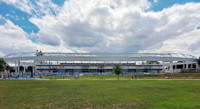
13.07.2024 © Bybbisch94 (CC BY 4.0) 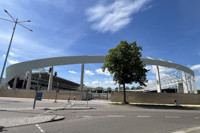
11.05.2025 © Frank Jasperneite 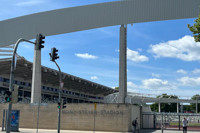
11.05.2025 © Frank Jasperneite 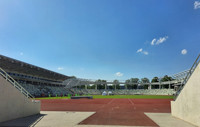
02.05.2025 © Bybbisch94 (CC BY-SA 4.0) 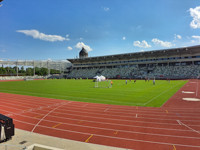
02.05.2025 © Bybbisch94 (CC BY-SA 4.0) 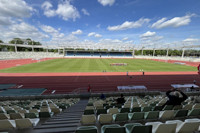
11.05.2025 © Frank Jasperneite 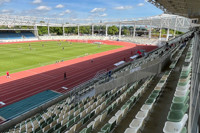
11.05.2025 © Frank Jasperneite 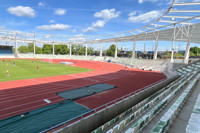
11.05.2025 © Frank Jasperneite 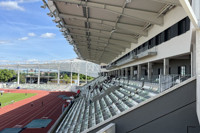
11.05.2025 © Frank Jasperneite 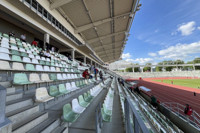
11.05.2025 © Frank Jasperneite 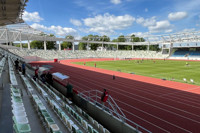
11.05.2025 © Frank Jasperneite 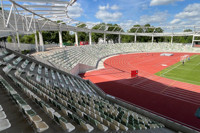
11.05.2025 © Frank Jasperneite 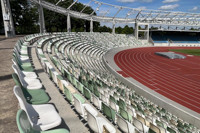
11.05.2025 © Frank Jasperneite 
11.05.2025 © Frank Jasperneite 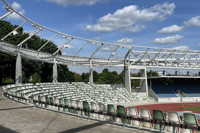
11.05.2025 © Frank Jasperneite 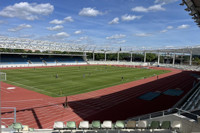
11.05.2025 © Frank Jasperneite 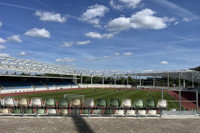
11.05.2025 © Frank Jasperneite 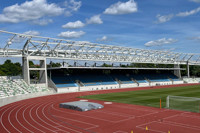
11.05.2025 © Frank Jasperneite 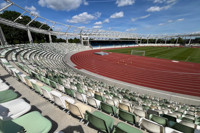
11.05.2025 © Frank Jasperneite 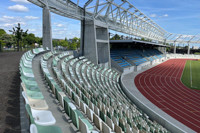
11.05.2025 © Frank Jasperneite 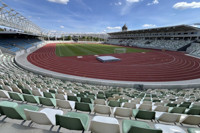
11.05.2025 © Frank Jasperneite 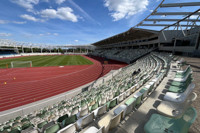
11.05.2025 © Frank Jasperneite 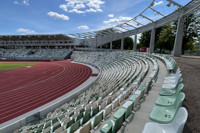
11.05.2025 © Frank Jasperneite 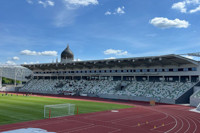
11.05.2025 © Frank Jasperneite

 StadiumDB
StadiumDB